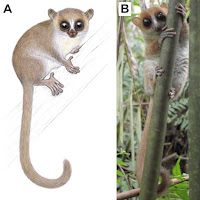 |
| Oryctorhynchus bairdi
Sues, Fitch & Whatley, 2020
|
ABSTRACT
This paper provides a description and analysis of cranial remains of a rhynchosaur from the Upper Triassic Evangeline Member of the Wolfville Formation of Nova Scotia, Canada. This material, primarily comprising jaw elements, represents the first definitive record of Late Triassic rhynchosaurs from eastern North America. All cranial bones can be assigned to Hyperodapedontinae. The dentition of the Nova Scotian hyperodapedontine differs from those of Hyperodapedon and Isalorhynchus. The maxilla apparently did not have more than two lateral rows and two medial rows of teeth. The teeth of the lateral row closest to the single groove dividing the maxillary tooth plate are more than twice as large as those of the medial row closest to the groove. The lateral and medial tooth-bearing portions of the maxilla become increasingly crest-like during ontogeny. The dentary lacks a lingual row of teeth. Based on this combination of features, the hyperodapedontine material from the Evangeline Member is assigned to a new taxon, Oryctorhynchus bairdi, gen. et sp. nov., which is the sister species to an unnamed hyperodapedontine taxon from Wyoming. This clade was recovered as the sister taxon to Hyperodapedon spp. in the phylogenetic analysis. The late Carnian or earliest Norian tetrapod assemblage from the Evangeline Member represents a mixture of faunal elements from a wide paleolatitudinal range, suggesting a more cosmopolitan distribution for continental tetrapods during the early Late Triassic than previously assumed.
SYSTEMATIC PALEONTOLOGY
REPTILIA Laurenti, 1768
DIAPSIDA Osborn, 1903, sensu Benton, 1985
ARCHOSAUROMORPHA Huene, 1946, sensu Benton, 1985
RHYNCHOSAURIDAE Cope, 1871, sensu Dilkes, 1998
HYPERODAPEDONTINAE Lydekker, 1885, sensu Schultz, Langer, and Montefeltro, 2016
ORYCTORHYNCHUS BAIRDI, gen. et sp. nov.
Etymology— From Greek oryktos, dug, mined, alluding to the inferred digging habits of rhynchosaurs and the derivation of the name ‘Minas Basin’ from the French ‘les mines,’ and Greek rhynchos, snout. The specific epithet honors the late Donald Baird for his pioneering work on Triassic tetrapods from Nova Scotia.
Hans-Dieter Sues, Adam J. Fitch and Robin L. Whatley. 2020. A New Rhynchosaur (Reptilia, Archosauromorpha) from the Upper Triassic of Eastern North America. Journal of Vertebrate Paleontology. e1771568. DOI: 10.1080/02724634.2020.1771568


















































